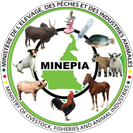ANIMAL HEALTH: NUCLEAR-DERIVED TECHNIQUES TO COMBAT PPR

In 2019, Babi DAIROU lost a third of his herd of goats when a viral disease attacking small ruminants (sheep and goats) broke out in the North Cameroon region. Of all the victims, he was the best off, as many of his neighbours lost their entire herds to this devastating disease, known by its scientific name Peste des Petits Ruminants (PPR). Today, the livestock in his village are safe from the disease, thanks to a mass vaccination campaign initiated by the Global PPR Eradication Programme, supported by the International Atomic Energy Agency (IAEA), the Food and Agriculture Organization of the United Nations (FAO), the World Organisation for Animal Health (OIE) and MINEPIA.
PPR is endemic in this region of Cameroon and its spread is facilitated by the movement of wild animals as well as domesticated herds across borders, so despite previous control campaigns, it has returned to Cameroon. In the north, where a narrow strip of Cameroonian territory cuts into the southern edge of the Sahel, the borders with Chad to the east and Nigeria to the west are never far away, so cross-border animal diseases can invade quickly. This part of the country, known as the north and far north, is home to 80% of Cameroon’s livestock, said Gabriel TOUMBA, regional coordinator of the Livestock Development Project (PRODEL), a World Bank-supported programme which coordinated the vaccination campaign on the ground. On average, 88% of small ruminants were vaccinated in each of the three years of the campaign, using vaccines produced by the National Veterinary Laboratory (LANAVET), located just 15 kilometres south of Garoua.
LANAVET produces 25 million doses of vaccine each year to combat various veterinary diseases affecting cattle, small ruminants and poultry. It carries out diagnosis and quality control using nuclear and related technologies (see The role of nuclear and related techniques in the diagnosis of PPR). Indeed, as a walk around its 1,200 square metre facility reveals, around half of its equipment has been donated by the IAEA through its technical cooperation programme and the VETLAB network of laboratories promoting research and the transfer of technology and information coordinated by the Joint FAO/IAEA Centre for Nuclear Techniques in Food and Agriculture based in Vienna (Austria).
The IAEA’s long-standing support, in partnership with the FAO, has included much more: the organisations have provided expert training and advice, as well as reagents and consumables to LANAVET to carry out its research and quality control, said Simon DICKMU JUMBO, Director of LANAVET’s Animal Diagnostics Department. This skills development, complemented by regular advice from the IAEA, led to the laboratory’s successful accreditation to ISO 17025, the only veterinary laboratory of its kind in Central Africa. As a result, it was able to increase its capacity and now supports several countries in the region by exporting seven different veterinary vaccines. Farmers in Benin, Burkina Faso, Chad, Côte d’Ivoire, Gabon, Ghana and Nigeria all benefit from LANAVET’s support, including the regional training courses and fellowships it now offers via the IAEA to veterinary researchers in these countries. As well as diagnosing diseases and producing vaccines, LANAVET also carries out quality control tests on veterinary medicines imported by Cameroon. This too uses nuclear and related technologies.
A RAPIDLY SPREADING EPIDEMIC
The diagnosis by LANAVET experts in 2019 confirmed the epidemic: 44% of the animals consulted were found to be infected. After the campaign, which led to the vaccination of around 5 million small ruminants nationwide, less than 5% of the sample consulted fell ill, and the ratio is continuing to fall, said Simon DICKMU JUMBO. “This is proof that LANAVET has achieved the main objective of the project with the IAEA: to help reduce poverty among small farmers through the control of PPR by supporting the national vaccination programme and informing the country’s vaccination strategy,” said Jumbo.
As the campaign comes to an end by January 2023, vigilance will be the order of the day, said Dr TOUMBA from PRODEL. The migration of wild ruminants and the mixing of herds driven across large tracts of land by farmer-breeders could trigger another epidemic at any time. To mitigate this risk, the government will remain on the alert and use its vaccination and control strategy to quickly stop the flow of any new epidemic, he added.
Vigilance on the part of breeders like DAIROU will probably be necessary until 2030, the target year for global eradication of the disease set by the FAO, which is supporting countries across Africa in the fight against PPR. “Only then can we be sure that PPR will not return from our neighbours,” said DAIROU.
SCIENCE
The role of nuclear and related techniques in diagnosis PPR enzyme-linked immunosorbent assay (ELISA) and polymerase chain reaction (PCR) are two nuclear-derived techniques used to diagnose the disease.
ELISA is easy to set up and use, making it suitable for any veterinary laboratory. Scientists place a diluted serum sample from an animal on a pre-lacquered microtitre plate and, if the sample contains antibodies to the suspected disease, this causes a change in the enzymatic reaction that alters the colours of the liquid, confirming the presence of the disease. ELISA is often used for initial testing and for screening large populations, but it cannot be used to accurately identify viral strains.
PCR is a nuclear-derived method for detecting the presence of specific genetic material from any pathogen, including a virus, in samples. Originally, the method used radioactive isotopic markers to visualise the targeted genetic material, but subsequent refinement has led to the replacement of isotopic labelling with specific markers, most often fluorescent dyes.

















